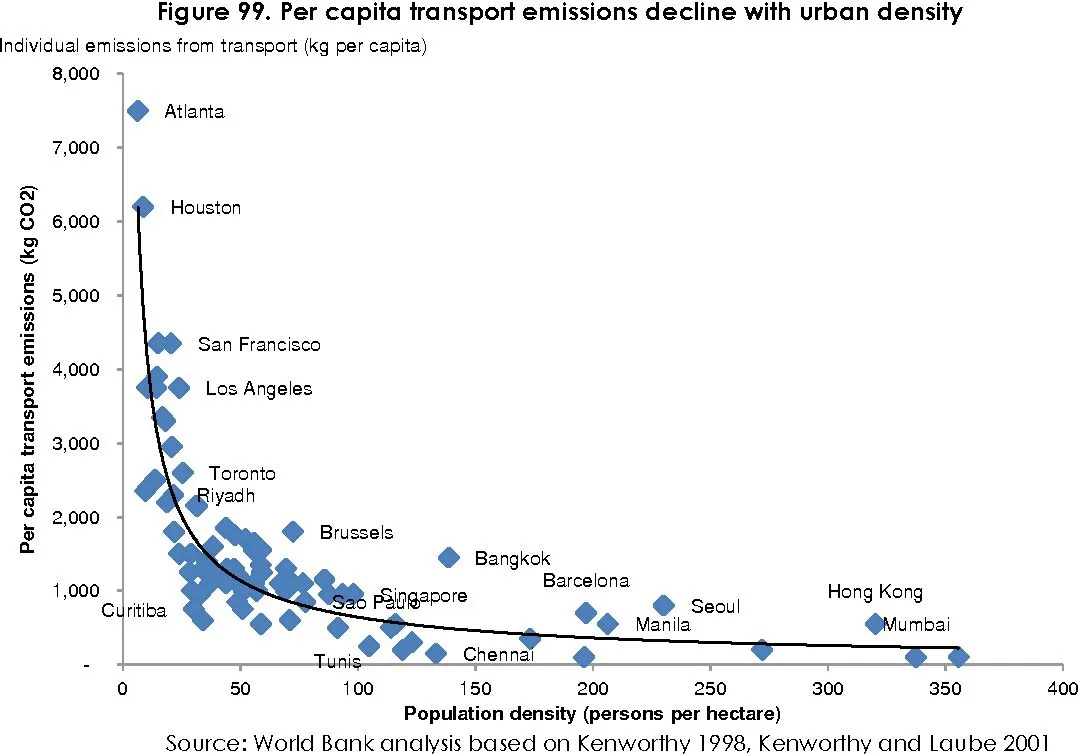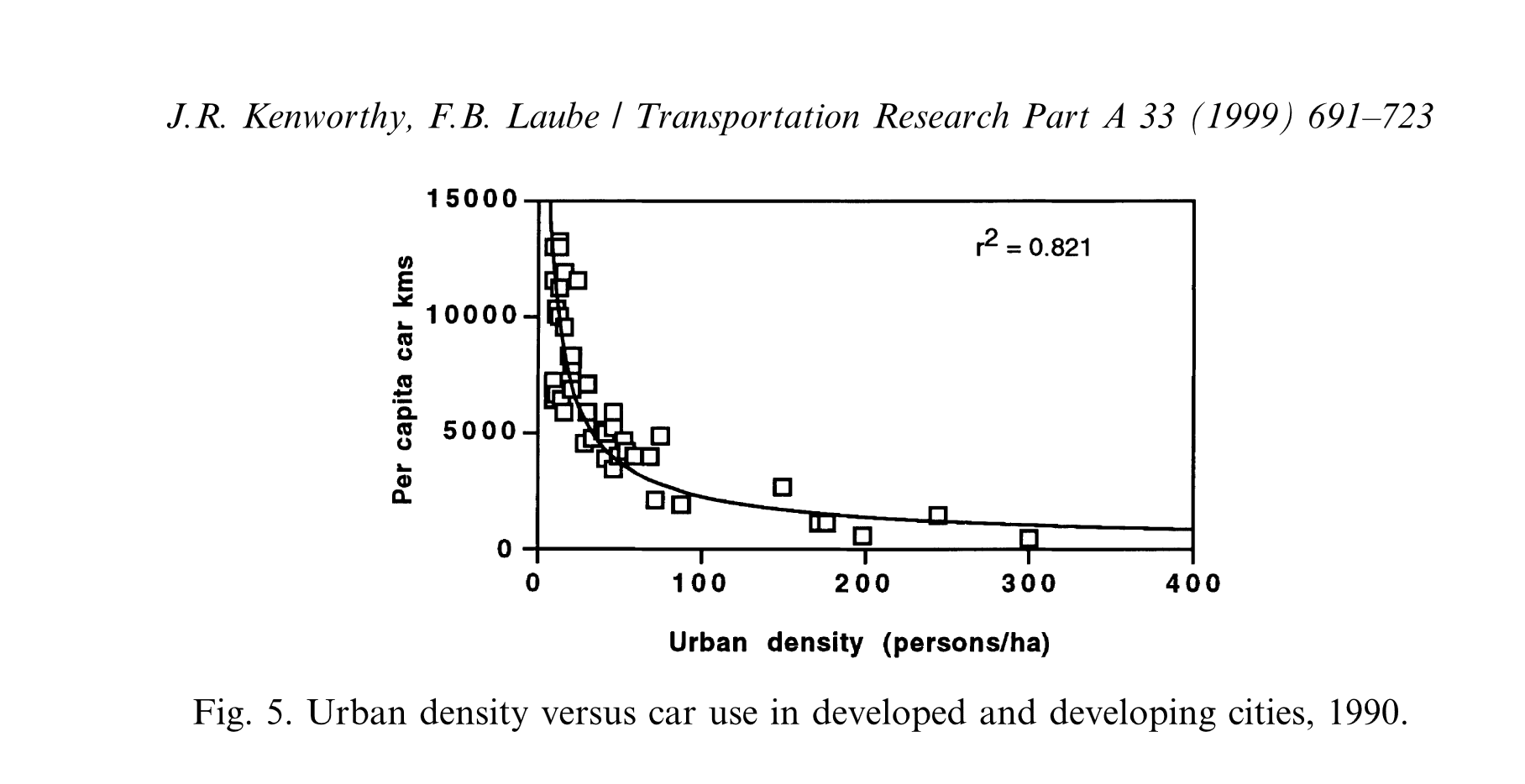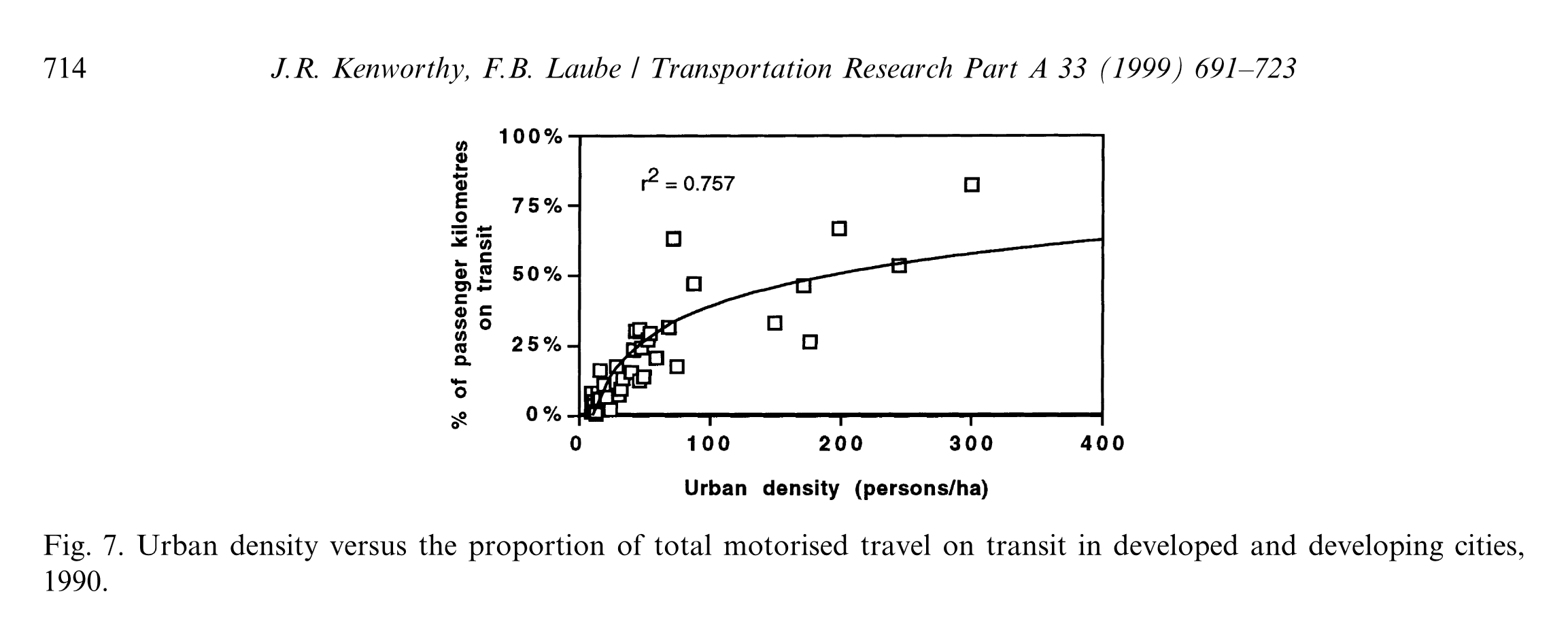Over the years I've done various density and walkability calculations, estimating that the required density could go as low as 4000 people/km2 (8000 people in a 12 minute walk) or even 3000 people/km2 (9000 people in a 15 minute walk.) But in the literature, messy as it is, it seems more like 10 du (dwelling units)/acre is the expected minimum, which at 2.6 people/du is more like 6500 people/km2. So I want to poke at my assumptions.
Summary: yeah, my old assumptions were flawed, and I'm now looking at closer to 10,000 people/km2 for good walkable density. Data indicates you start getting more walking before that, like 5000/km2, but it levels off above 10,000, possibly because all the trips it is easy to make walkable, have been made walkble. And per older posts, you can reach these densities with single-family housing if you insist, though you'll need to accept small lots and yards.
My old assumptions
Why did I first consider a 12 minute walk? To be honestly, mostly because it gave 1 km 'radius' at 5 KPH walking speed, and 1 km was a nice round number, and 12 minutes felt like an acceptable maximum. Why did I consider a 15 minute walk? Because of all the "15 minute city" brouhaha, so lots of other people are already considering it.
Do I want to walk 15 minutes to my supermarket? Heck no. I start whining above 10 minutes, probably because for the vast majority of my life I've lived at 9 minutes or less, sometimes much less. But is there data beyond my personal vibes? Kind of:
- USDA defines "access-burdened" households as both not having a car and living beyond 0.5 miles of a grocery store.
- A reddit poll found half the people willing to walk half a mile.
- This says most people are unwilling to walk more than half a mile regularly; it gives no source, but I feel the authors would know more than I do.
- This article says odds of walking go up a lot when within 800 meters of a train station and 1000 meters of a supermarket; it also shows walking jumps a lot between the 15-20 du/hectare bin and the 20-30 du/hectare bin. (10 du/acre = 25 du/hectare.)
- This considered 20 minute density, but that's 20 minute round trip, so 10 out.
So, even though it's kind of also a round number, I'll consider 10 minutes / 0.5 mile / 800 meters as a radius.
What would be non-arbitrary is where it's actually faster to walk than to drive, but that's dependent on urban form as much as on density. Going from your driveway to a store parking lot is different from having to walk down the street to where you parked (and then finding another curbside space on return), which is different from your supermarkets not having car parking (as was the case in Osaka). And 'free' parking is different from having to pay; I'd guess even paying a quarter for parking would add like a minute to people's willing walk distance, just out of "it's the principle of the thing."
Also, considering a single distance is itself a bit suspect. I'm more willing to walk further for infrequent trips (dentist, special shopping, special restaurant) or destinations that take all day (work, school), than for frequent brief trips (groceries, cheap takeout.) And as a parent there's a difference between sending your teen off on a 20 minute walk to school, vs. making the same trip yourself 4 times a day (drop-off round trip, pickup round trip.) So it's less "15 minute" city and more like "10 minute supermarket, 20 minute high school" city.
Another key assumption was that being able to access 8000 people was a good target, so as to support a supermarket. The idea is still sound, but I'll be more conservative. Per this, the US has around 12,500 people per "conventional supermarket", or 9600 people per store including "limited assortment" (like Aldi) or supercenters like Wal-Mart. (This leaves out more expensive natural/gourmet stores like Whole Foods, and club stores like Costco. 8700 people if you include the first category.) I've previously found the US has 6000 people per pharmacy, so that's covered. 9600 people is around 120 people per age-year, so 600 students for a 5-year elementary school, enough for an average school.
I think my old models were also seeking a minimum density that could possibly be viable, especially if people didn't have access to cars. This is rather different from a density that would get people choosing to walk even when they have the option of driving (or choosing not to own a car when they could.)
I'd also had thoughts like "well, 15 minutes is the max, but most people will be under it." But if you have uniform density, a majority of people will actually be near the max. 125/225 = 5/9 of people in a 15-minute radius will live between 10 and 15 minutes from the center. Conversely, if you had clumped density like Japan, then you really could argue "most people will be close in, and the outer majority made a choice to trade time for space". I'll stick to uniform density, because it's simpler but more because it's been what North America loves. Just keep in mind that it's handicapping ourselves, compared to letting buildings rise near train stations and shopping centers.
Calculation
So! Target radius 10 minutes, half-mile, 800 meters. Target population 9600 people. Area of a grid diamond is 0.5 square miles, 1.28 km2. 19,200 people/mile2, 7500 people/km2. 11.5 du/acre, 29 du/hectare. Roughly in line with the literature. Gets you cheap food, medicine, and an elementary school within a 10 minute walk, and by implication various restaurants and dentists.
How about a middle or high school? A 15 minute walk (2.25x the area) gets you 21,600 people, 270 kids per year, so 810 for a 3-year school, or even 540 for a 2-year middle school. 20 minutes (4x the area) gives 38,000 people, 480 kids per year, 1440 for a 3-year school, or 1920 for a 4-year high school.
Hardware stores? I'm not sure, actually. This gives me around 25,000 per hardware store, so within 20 minutes, while this gives 8900 people per "DIY and home improvement" store, within 10 minutes. Of course, many things you buy at such a store are the things you don't want to walk home. On the other hand, they probably deliver.
The wider areas also give you recourse if your nearest supermarket raises prices or goes out of business; you should have an alternative within 15 minutes. Even nicer, though, would be 2 markets within a 12 minute walk, on the grounds that you're unlikely to be that distant from both markets. 12 minutes is 1 km radius, 2 km2, so you'd need a density of 9600 people/km2, or nearly 15 du/acre.
Reality Check
So, I (once again) have identified a neighborhood density that feels like it should be able to pull people out of their cars, at least for lots of trips. Can we check it?

Source. Note that transport emissions have largely collapsed by 5000 people/km2, with a slower decline to 10,000 and beyond. It could be from driving shorter distances as well as more trips without driving at all, but it's very striking.


Source (pdf). Similarly huge changes by 10,000 people/km2, but also significant changes as early as 5000. Perhaps catching the people who are willing to spend more time to avoid driving.
This article looks at just three Canadian cities, but finds similar results. I'll hotlink just one graph. Note an inflection point, this time around 9400 people/km2. (Though the Montreal graph doesn't have a really obvious inflection, it just keeps going, approaching 80% much sooner than Toronto or Vancouver.)

Finally, there's this presentation, with less dramatic data than Kenworthy and Laube, but tending to show shifts in walk mode share by 20 people/acre, or 5000 people/km2. I think it's the only thing I've found directly graphing walking vs. density.
Why is there an inflection point?
Part of it is simple math. Car use cannot go below 0%, so as density increases, the curve has to level off. But I think there's a deeper reason why the inflection point is around here: some trips are easier to convert to walking than others.
A post office trip is completely generic: you don't care which one you go to, and will go wherever is closest. Many other trips are semi-generic to varying degrees: you might care which supermarket you go to, or which elementary school you use, but a lot of the time proximity will win. Once they're in walking distance, many people will walk to them. You might care more about your hairdresser, but even so, having more within a radius means a higher chance that you can find someone acceptable, vs. going across town after you move.
But lots of other trips are not generic, and instead go to some distinct point of individual interest. A job you're attached to. Your family -- if your parents live 5 miles north, and your wife's parents live 5 miles south, your family is going to travel a lot no matter how dense the city is. Big cities tend to have bigger zoos and museums rather than proportionally more of them.
So once you hit 10,000 people/km2, most generic trips are within a 10 minute walk, or certainly a 20 minute one. Higher density doesn't change that much; it can give you more choices and bring things even closer to home, but you were already walking to groceries, you can't switch from driving to walking again.
But higher density doesn't magically bring individual trips within reach. It does provide more things within walking reach, but also provides more things of interest outside of reach: more dating partners, jobs, friends and family members. If a city is geographically large then there's a good chance that things of interest will be elsewhere in the city, especially as people move around. Higher density would only help if it also shrank the city to be more within walking distance. But if you keep adding people across an area, at some point all the generic trips are walkable, but you keep adding reasons to have individualized non-walking trips. For that you need a good transit system -- which, granted, higher density does help pay for.
There are other benefits to higher density, of course: more taxpayers to pay for infrastructure, more riders to justify high transit frequency, letting more people live close to attractive points like subway stations, letting people have more and more interesting lives in walking or biking distance. But in terms of reducing car trips in favor of walking, the low-hanging fruit gets plucked by 10,000.
no subject
Date: 2024-06-11 08:46 (UTC)From:Most post office functions have moved online too - though I disagree that post offices are generic: I can definitely think of post-offices in smaller communities that still exist *because* they have loyal customers and are an important part of the community, which allows them to provide niche services and products as a sideline that they only know people want because they are at the heart of their community.
Things you can't get online: prepared food served within minutes of your getting hungry, hot drinks, community spaces for meetings and events. Groups doing knitting, photography, art, dance, yoga, reading circles, warm rooms, charity fundraisers, gardening clubs. For most of these, you don't need a commercial opportunity, you just need enough people to want it and somewhere for it to happen, which could be a tin shed or a pub or even a library.
Pharmacy is a good one because there are lots of expertise & services that pharmacists offer that can't be replicated by an app.
A desert of solitary dwellers arranged to make a supermarket commercially viable by walking doesn't seem like a good place to live so much as a place with cafes, pubs and community spaces is so much more pleasant, and community spaces tend to appeal to the people who don't or can't drive, too. Though if there was one thing I'd LOVE in any neighbourhood, it's a local bakery. If I were king of the world I'd offer generous start-up incentives and training to bakers, on the grounds that fresh bread is an asset in all places :-D
no subject
Date: 2024-06-11 17:06 (UTC)From:Due to some quirk of development, I can walk to 7 different grocery stores here despite a density of probably 4000-4500/km2. They all seem quite busy, with lots of cars in the ones that have parking lots. And this is a well-off area, though maybe "want to buy my produce" beats "could afford delivery fees", I dunno.
I admit that I am also 'planning' for the kind of place and lifestyle I like[1], which includes being able to run to a non-convenience store for more spinach at will, and not having to plan for delivery time windows, or paying for delivery charges, or making sure orders are big enough to waive delivery charges. (If that's even a thing. My one experience with grocery delivery was quite expensive, like a 60% markup IIRC. I did do a lot of curbside pickup in 2021 (to avoid going inside) with the fee waived for orders over $35, but that's pickup.)
([1] Japanese society isn't perfect but its cities are pretty close to perfection for me.)
I don't think it matters much if some heavy bulk things are delivered; as long as a lot of shopping is done in-person, people will want quick access to a store.
Because a supermarket requires so many people, it also works as a stand-in for lots of other things that require fewer customers. If there are 10,000 people for a super, then there are (on USA average) enough people for 4-5 convenience stores (Japan also has 2000 people per konbini), 20 restaurants, 6 dentists, presumably (I haven't done the math) some bars and coffeehouses and bakeries, etc. It's not "all you need for a neighborhood is a supermarket" but "if you can support a supermarket by foot traffic, you can support most other things as well." (I may have taken that for granted without spelling it out here, relying on past posts.) Some big exceptions being high schools (especially larger ones), hospitals (US seems to be about 66,000 people per hospital, so even a 20 minute walk requires a bit higher density, 13,000 people/km2), colleges (bigger than high schools, and not everyone goes, so need a lot more people), and clustered jobs.
I wonder if UK post offices are sufficiently different from US ones, or if it's a small town vs. big city thing. The idea of a US post office providing special community services is alien to me.
Anyway, thank you for reading my long nerdy post!